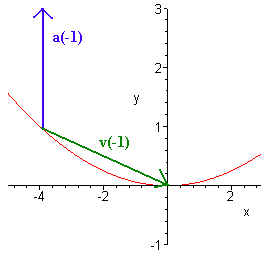Velocity and Acceleration Definition of Velocity and Speed In single variable calculus the velocity is defined as the derivative of the position function. For vector calculus, we make the same definition.
Example Find the velocity vector v(t) if the position vector is r(t) = 3ti + 2t2j - sin t k Solution We just take the derivative v(t) = 3i + 4tj + cos t k When we think of speed, we think of how fast we are going. Speed should not be negative. In one variable calculus, speed was the absolute value of the velocity. For vector calculus, it is the magnitude of the velocity.
Example Let r(t) = 3i + 2t j + cos t k Find the speed after p/4 seconds. Solution We first find the velocity vector v(t) = r'(t) = 2 j - sin t k We have v(p/4) = 2 j - Its magnitude is the square root of the sum of the squares or Speed = || v || =  In one variable calculus, we defined the acceleration of a particle as the second derivative of the position function. Nothing changes for vector calculus.
Example Find the velocity and acceleration of the position function r(t) = 4t i + t2 j when t = -1. Then sketch the vectors. Solution The velocity vector is v(t) = r'(t) = 4 i + 2t j Plugging in -1 for t gives v(-1) = 4 i - 2j Take another derivative to find the acceleration. a(t) = v'(t) = 2j Below is a picture of the vectors.  Since the velocity and acceleration vectors are defined as first and second derivatives of the position vector, we can get back to the position vector by integrating. Example You are a anti-missile operator and have spotted a missile heading towards you at the position re = 1000i + 500j with velocity ve = -30i + 3j You can fire your anti-missile at 100 meters per second. At what angle should you fire it so that you intercept the missile. Assume that gravity is the only force acting on the projectiles. Solution The acceleration vector of the enemy missile is ae(t) = -9.8 j Integrating, we get the velocity vector ve(t) = v1 i + (v2 - 9.8t) j Setting t = 0 and using the initial velocity of the enemy missile gives ve(t) = -30 i + (3 - 9.8t) j Now integrate again to find the position function re(t) = (-30t + r1) i + (-4.9t2 + 3t + r2) j Again setting t = 0 and using the initial conditions gives re(t) = (-30t + 1000) i + (-4.9t2 + 3t + 500) j The acceleration of your anti-missile-missile is also ay(t) = -9.8 j Integrating, we get the velocity vector vy(t) = v1 i + (v2 - 9.8t) j Since the magnitude of our velocity is 100, we can say vy(0) = 100 cos q i + 100 sin q j So that vy(t) = 100 cos q i + (100 sin q - 9.8t) j Now integrate again to find the position function ry(t) = (100t cos q + r1) i + (-4.9t2 + 100t sin q + r2) j Our anti-missile-missile starts out at base, so the initial position is the origin. All the constants are zero. ry(t) = (100t cos q) i + (-4.9t2 + 100t sin q) j Since we want to intercept the enemy missile, we set the position vectors equal to each other. (100t cos q) i + (-4.9t2 + 100t sin q) j = (-30t + 1000) i + (-4.9t2 + 3t + 500) j Equating coefficients gives 100t cos q = -30t + 1000 -4.9t2 + 100t sin q = -4.9t2 + 3t + 500 The first equation gives 1000 t = 100cos q + 30 Simplifying the second equation and substituting gives 100000 sin q 3000 100cos q + 30 100cos q + 30 Clear denominators to get 100000 sin q = 3000 + 50000 cos q + 15000 At this point we use a calculator to solve for q to q = .62535 radians |
MANIC FM
Saturday, July 24, 2010
Vectors Calaulus 1.7
Subscribe to:
Post Comments (Atom)
No comments:
Post a Comment